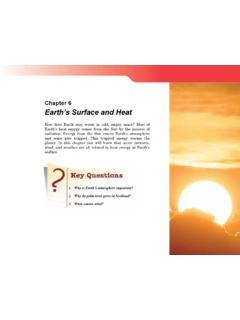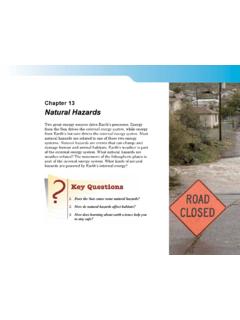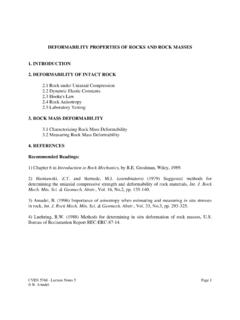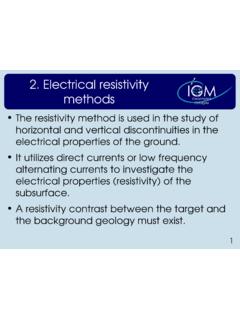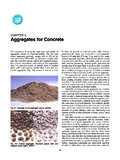Transcription of Chapter 11 Water and Weathering - tclauset.org
1 Main Menu Table of Contents Back Chapter 11. Water and Weathering In Unit 2, you learned about energy in the Earth system. In Unit 3, you learned about plate tectonics, earthquakes, and volcanoes. These are examples of Earth systems that are driven by internal energy energy that comes from the heat of Earth's core. This Chapter describes how rock is weathered (broken down) and moved from place to place by Water . These processes are driven by external energy energy from the Sun. 1. What does a young mountain look like? 2. What does a meandering river look like? 3. In what kind of rock are most fossils found? Main Menu Table of Contents Back Weathering Energy from the Sun warms and cools Earth's surface. It melts and freezes Water . It even helps grow the tree roots that eventually can split rocks into pieces.
2 In this section, you will learn how tall mountain ranges eventually break down into the smallest rock particles. Mountains Mountains Mountains because they are so big and impressive seem to be change over time unchanging features in a landscape. However, mountains wear down over time. In fact, due to the Sun's energy, wind, and Water , mountains begin to crumble as soon as they are formed. Old versus young An good example of old mountains are the Smoky Mountains Figure : The rounded peaks of mountains which are part of the Appalachian Mountain range (Figure ). the Smoky Mountains near Linville, Tennessee. Vegetation covers the These mountains are very old. The Rocky Mountains in the mountains all the way to their peaks. western United States are younger mountains (Figure ).
3 How do these two mountain ranges differ? What happens as At one time, the Smokies were as tall as the Rockies and also had mountains age? sharp peaks. But, since the Smokies are 680 millions of years old (hundreds of millions years older than the Rockies) the peaks have worn down. Eventually, the Smokies will be no more than rolling hills, and the Rockies will look like the Smokies do now. Figure : Sharp peaks of the Canadian Rocky Mountains near Jasper, Alberta Province, Canada. 232 UNIT 4 THE SHAPE OF EARTH'S SURFACE. Main Menu Table of Contents Back Chapter 11: Water AND ENERGY. Physical Weathering Weathering How is a large mountain broken down into tiny grains of sand? The process of breaking down rock is called Weathering (Figure ). Weathering - the process of breaking down rock.
4 Physical Physical forces may break or chip rocks into smaller pieces. This physical Weathering - physical Weathering process is called physical Weathering . Physical Weathering may forces that break rocks down into break large blocks loose or chip away tiny grains, one at a time. smaller pieces. Liquid Water Liquid Water is a physical Weathering agent. rocks break up frost wedging - physical Weathering that results from quickly when running Water knocks them against each other. freezing Water . Even running Water alone wears away rock. You can see physical Weathering by looking at rocks at the base of a waterfall. Running Water rounds and smooths the rocks there. Frost wedging Water weathers rock in other ways too. Frost wedging is a powerful physical Weathering agent. When Water cools, it contracts like other matter.
5 But just before it freezes, it expands a little bit! Say a small amount of Water enters a tiny crack in the rock. When the Water freezes, it expands, making the crack a little wider. More Water enters the crack, freezes, and widens the crack even more. Figure : This course sand and Eventually frost wedging splits gravel is all that remains of a once-tall peak in the Sierra Mountains. apart the two sides of the crack. The photo above shows an example of frost wedging near the crest of Mount Hoffman in the Sierra Mountains. Many hand-sized rocks have been split away by frost wedging. Weathering . 233. Main Menu Table of Contents Back Glaciers Frozen Water in the form of glaciers is another powerful physical Weathering agent. The ice that forms glaciers is a plastic solid (a solid that flows).
6 As the ice of a glacier flows down a valley, it grinds the valley floor with pieces of rock caught up in the ice (Figure ). This grinding changes the shape of the valley so that its bottom is rounded. Figure : A glacier passed over this rock moving from left to right. The scratches were made by rocks caught in the moving ice. A U-shaped The image above is of a large valley that held a glacier during the glacial valley last ice age. The valley floor rises up smoothly in a gentle curve to the ridge above. From the side, this glacial valley is U-shaped. Notice that the highest part of the ridge is rough. This is because the glacier didn't get that high up before it melted. The change from smooth to rough rock is the bathtub ring left by the glacier that shows the highest point the glacier reached on the mountain.
7 Wind Even wind is a physical Weathering agent. Wind-blown sand chips away tiny bits of rock from the surface of exposed rock. During this Figure : Wind-blown sand has process, the remaining rock can take on unusual shapes and the physically weathered this sandstone removed bits eventually become sand (Figure ). into tall pillars called Hoodoos. 234 UNIT 4 THE SHAPE OF EARTH'S SURFACE. Main Menu Table of Contents Back Chapter 11: Water AND ENERGY. Chemical Weathering Chemical Rock is also reduced to smaller pieces by chemical reactions Weathering between Water and rock grains. This process is called chemical Weathering - chemical Weathering . Some kinds of rock are more easily Weathering of rock that involves chemical reactions. eroded by chemical Weathering than others.
8 For example, marble is chemically weathered much faster than granite. Chemical Weathering has worn away the surfaces of many old marble statues (Figure ). This is seen more often in Europe than in the United States because the statues in Europe are older. They have been exposed to chemical Weathering for a longer time than most marble statues in the United States. Physical and Both physical and chemical Weathering can affect rock at the same chemical time. Look at the picture below. Originally there were a few tiny Weathering cracks in the rock. Frost wedging probably opened up these cracks. Now chemical Weathering is changing the rock mineral so that the sides of the crack are filled with loose grains. You can see the tufts of plants growing in the loose grains of rock.
9 Figure : An old marble statue. Notice that the face of the statue has been worn down by chemical Weathering . Weathering . 235. Main Menu Table of Contents Back Root wedging and rockfalls Root wedging Plant roots may grow into small crevices. If these plants are sturdy, like trees, they exert force on the rock as they grow. This force is often strong enough to split the rock. This process, called root wedging, is a kind of physical Weathering (Figure ). However, roots also produce enzymes that attack rock minerals. So root wedging is really a combination of physical and chemical Weathering . Rockfalls Falling rock can break into very small pieces when it hits the ground. The graphic below shows an example of rocks (and trees!). affected by falling rock. Rockfalls can occur when a big chunk of rock is split off of a large landform by frost wedging or root wedging.
10 Rockfalls speed up the Weathering process by quickly breaking up large pieces of a rock formation. Figure : For the moment, the climbers are happy to secure their rope to the small pine tree. Over time, the tree's roots will split away their rocky perch from the cliff by root wedging. 236 UNIT 4 THE SHAPE OF EARTH'S SURFACE. Main Menu Table of Contents Back Chapter 11: Water AND ENERGY. Section Review 1. You have learned that mountains form when two continents Find an outdoor place near your collide. How do mountains turn into small rocks , soil, and sand? house that will not get disturbed. 2. Does the Sun play a role in Weathering ? Explain your answer. Make a pile of soil and rocks . You may want to put a sign near your 3. Name two differences between old and young mountains.



